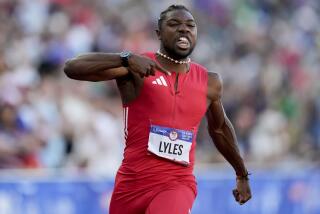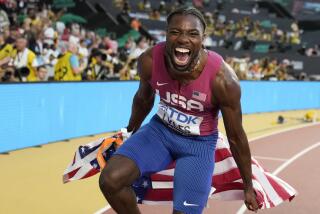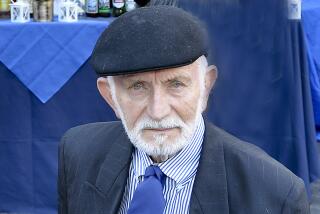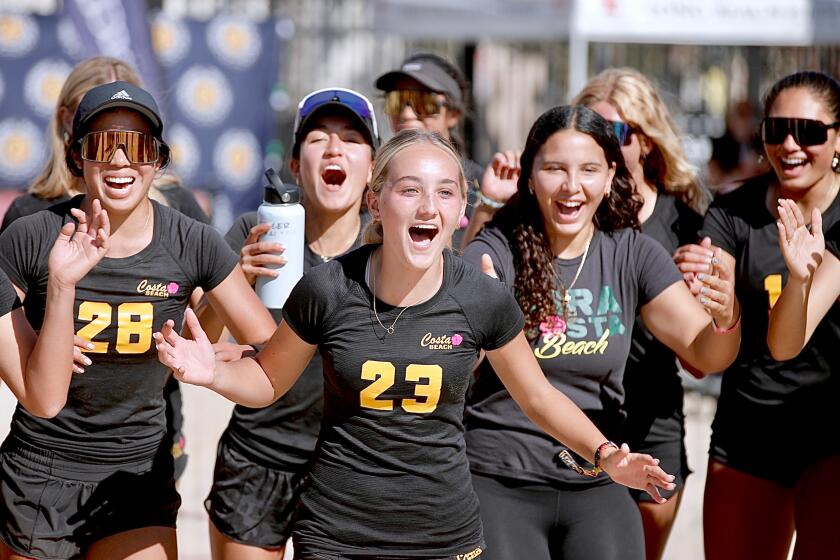Behold Blazing Buckeye : Reynolds Is Set to Make a Run at 400 Record
- Share via
COLUMBUS, Ohio — The school that brought you three yards and a cloud of dust is now proud to present 400 meters and a bolt of lightning. Not that Ohio State no longer has football. Just that once more, it has track.
Rather, it has Butch Reynolds, whose nearly unseen progress around the track is attended by nothing more than a faint smell of ozone, forget the dust. He reminds some very old Buckeye fans that the school had Jesse Owens long before it had Woody Hayes.
Any day now, he will be as famous among track buffs as the old Wood man was among football fans. At the recent Jesse Owens meet--Reynolds passes Owens’ bronzed shoe daily on the way to the track office--the Ohio State junior ran the fastest sea-level 400 in history, 44.10 seconds.
When he runs the same event in the USA-Mobil Outdoor Track and Field Championships, the national meet sanctioned by The Athletics Congress, at San Jose next weekend, one of the two oldest records in track and field will be in definite jeopardy. It’s the world record for the 400, 43.85, from the 1968, altitude-aided Olympics.
Reynolds, unbeaten in five 400 races this season, including the recent National Collegiate Athletic Assn. meet, is not exactly track’s best kept secret, although he’d still be a good guest if “What’s My Line” made a comeback.
But his prominence is so sudden that hardly anybody else can place his name. Up to a year ago, when he had to take a loan out to pay his own way to Ohio State, not many track coaches could put a face to it.
“He’s one that everyone should reckon with,” says UCLA assistant coach John Smith, who watched Reynolds win in the NCAA meet. “Right now, he’s making a statement. His name’s going to become household.”
Keep in mind that Reynolds is something of a late bloomer, not to mention a virtual non-trainer. This is a kid who couldn’t even make his seventh-grade track team. But never mind that. This is a kid who couldn’t even make a freshman college team.
Coming from Akron, he had an offer from West Virginia to play basketball, and offers from the University of Akron and Miami of Ohio to play football. Zero offers to run track.
Frank Zubovich, Ohio State coach, what in the world were you thinking when you first passed on this zephyr?
“Well, let’s just say we didn’t see enough of him. His, uh, name never really came up.”
But don’t get down on Coach Zoo, as he is called hereabouts. The only Reynolds anybody knew about in this rust belt had something to do with aluminum foil.
Nobody knew this kid. He scratched in the state high school meet, the annual prep showcase, when he twisted an ankle. Anyway, “he didn’t have great times” before that, Coach Zoo said. “His best time was something like 48.1. That is not a super-good time.”
Reynolds, who had run only two years of track in high school, nevertheless had decided that he’d rather run through a tape than a defensive line. “So I called people,” he said. “Just cold, called coaches, told them my times.”
Sounds kind of undignified for somebody who could develop into a world record-holder, right? Well, there’s more to his discovery than that, although it doesn’t add much dignity to his story.
Seems that Roger Bowen, then an assistant coach at Kansas, was at the national meet at Houston in 1982. He was lounging by the pool when the Western Michigan coach, like Bowen an Ohio boy, said: “Hey, could you use a quarter-miler? We’re flat full of them, ourselves. But check this Reynolds kid out.”
Bowen did, but couldn’t get him academically flagged at Kansas, so he referred him to Butler County Community College in El Dorado, Kan. Anyway, by the time Reynolds called, Butler Coach John Francis was willing to listen to the kid’s times.
The story does not take an immediate Cinderella turn here. Francis had reason to discredit both Bowen and Reynolds at first. Reynolds has become notorious for bad workouts. “Butch!” Francis would scream, “I bring you away from Ohio and you can’t even win one interval?”
Butch’s reply was something less than confidence-building. “Coach, I’m running as hard as I can.” He was, too.
It’s just that Reynolds, for whatever reason, can run harder in meets. Rather, he runs harder nearer the finish. “Something about him,” Bowen marvels. “He has a nose for the finish line. He seems to shift a gear.”
Adds Zubovich: “You see kids coming to the finish line, they tie up, the bear jumps on their back, whatever you want to call it. I’ve never seen him tie up at the end of the race. He’s unique in his ability to maintain a fast tempo throughout the race.”
So it was that Reynolds, who couldn’t win his intervals at Butler, set indoor and outdoor junior college records with 400 times of 47.08 and 45.34. Finally, you might have predicted, Reynolds was about to come into his own. And in 1984, an Olympic year! How very nice.
“But my story is all about having the worst luck at the worst times,” Reynolds says.
Just as in his prep showcase, he flopped in the Olympic trials.
“I was training for the nationals, which I won, with 45.47. But I was running that for then . I was running those races too fast, too soon.
“Man, I didn’t know anything about track, didn’t even know the names of the people I lined up with. Carl Lewis I maybe could have placed, but nobody else.
“So I’m sore from my ankles to my groin by the time of the trials. I can hardly walk, I’m so sore. Just so sore . In the race, I actually stopped. Pulled up. The only reason I started running again was all those people in the stands. I didn’t want them to think I quit.”
Bowen, at nearby Kansas, didn’t see a quitter or even a slug. He continued to recruit him for Kansas, right up to the time he was offered a job as an assistant coach at Ohio State.
Then he called and said, “Butch, we’re going home.” Bowen is kind of proud of himself for that recruiting tack. “He bought it,” he says.
Is this when Reynolds finally begins leaping tall buildings, etc.?
“Well, no,” Zubovich admitted. “I hate to use the word injury-prone but . . . “
Coach Zoo, use it. If Reynolds were any more fragile he’d wear “Do Not Touch” instead of a number on his back.
Bowen said that every time Reynolds was poised to accomplish something, his hamstring got sore.
“His first meet in the nationals, on the boards (indoors), his hamstring flared up and he didn’t compete in the finals,” Bowen said.
“Wrong things, wrong times. Last year, we got to the conference meet, he wants to run the 4 x 1 (400 meter relay). He gets through trials. Saturday, he gets to finals, then goes the hamstring.”
But the coaches, and Reynolds, have learned that his body is both to be admired and babied.
Said Reynolds: “I’ve learned to listen to my body, do the right things at the right times.”
That means a somewhat unorthodox training program.
“I hate to say we don’t work him hard,” said Zubovich, the man who also hated to say Reynolds was injury-prone. “But we have, uh, modified his training to suit the conditions.”
Reynolds doesn’t run at all for three or four days after a meet. And he doesn’t always run before one. Zubovich puts him on a bike or in a pool to keep his aerobic conditioning up, but otherwise doesn’t prod him around the track.
This goes against the grain of any coaching discipline, but Zubovich has learned that “training athletes is a finely balanced thing. Sometimes I wonder what he could do if I could work him a little harder.”
Bowen said: “He’s probably trained 75% of what he could do. Maybe that’s good. But we can’t help sitting around wondering what he really could be doing.”
As it is, he’s doing pretty well. Though he will earn his fame as a quarter-miler, he has set records in other events.
At that Jesse Owens meet, for instance, he ran a 20.46 in the 200-meter preliminaries to break guess-who’s school record of 51 years. He briefly held the world best time of 1:00.86 in the 500 meters indoors, and he ran the fastest time of the indoor season on the 600-yard track, 1:06.87.
Before it’s over, well, Butch Reynolds will not make anybody forget Jesse Owens, any more than Earle Bruce has made us forget Woody Hayes. But looking at the trophy case outside the track office, one thinks there might be room for at least one more bronzed shoe.
More to Read
Go beyond the scoreboard
Get the latest on L.A.'s teams in the daily Sports Report newsletter.
You may occasionally receive promotional content from the Los Angeles Times.










